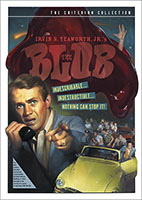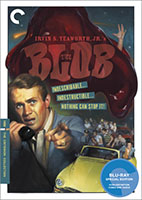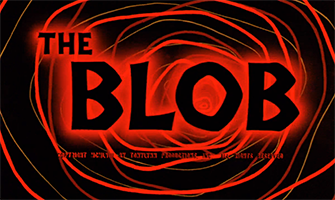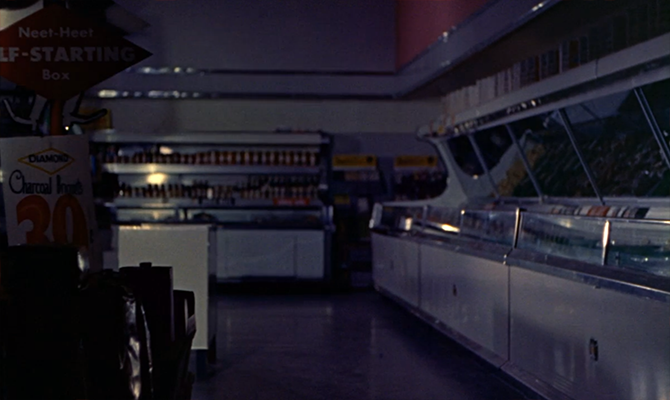2000:  2013 Blu-ray:
2013 Blu-ray: 

directed by Irvin S. Yeaworth, Jr.
screenplay by Theodore Simonson and Kate Phillips
from an original idea by Irvine H. Millgate
Criterion #91.
In The Blob, newcomer Steven McQueen has a spectacular part — IN HIS HAIR — as a post-juvenile linquent known as “Steve.”
As in “Hey, Steve!” “Steve, what is it?” “Steve! Steve, help!” “I don’t think it can be killed, Steve!” and so forth. If you drink every time someone says “Steve” you will take at least 56 drinks. According to wordcounttools.com, the 5 most frequent non-trivial words in a complete transcript of The Blob are:
1. know
2. don’t
3. it’s
4. Steve
5. right
By the way, kids, I want to be clear that “drinking games” aren’t cool, and there’s really no need to drink alcohol to have fun watching The Blob, which is a wholesome movie, brought to you by your Christian neighbors at Good News Productions in Chester Springs PA, makers of 16-millimeter religious films. (In the commentary the producer calls them “a bunch of very nice monks.”) They’ve put together some good old-fashioned secular fun, suitable for the whole family. It’s the horror-movie equivalent of Family Circus. Sit back, enjoy yourself. We think you’ll get a few chills, you’ll chuckle, you’ll see a real sincere story with some exciting young people in it, you’ll go home feeling like you just had a fine soda pop. Then you’ll get some rest and be up and ready for church in the morning.
What works: Beautiful glowing color — Steve’s car must be the bluest in all moviedom — and black-as-indoors night skies, heavily cricketed. Feels like you’re at a nice low-key Halloween party. Investment in the good film stock and the good lab paid off. (From the commentary we learn that the film was substantially financed by the guy who owned the lab.) The bright red shiny Blob looks terrific on screen, and the goofy special effects are graphically pretty charismatic compared to most cheap-o movies. This stuff matters.
Because frankly if it weren’t for the delicious ice-cream-truck palette, this would be pretty hard to take. Every other scene aggressively, cheerfully wastes the viewer’s time. The script is the story of “The Blob” as I would have fleshed it out out in 5th grade. Dialogue a la The Young Visiters:
COP: Mr. Martin, Mr. Andrews, apparently Doc Hallen’s office was broken into by vandals tonight, and Steve and Jane seem to know something about it.
MR. MARTIN: Vandals? My daughter?
MR. ANDREWS: Well, you don’t think our kids were mixed up in it, do you?
COP: All we know is that they told us something had happened over at Dr. Hallen’s house. We’re not accusing anyone of what we found. Now, we can’t be more definite until we contact Dr. Hallen in Johnsonville.
STEVE: Dad, it isn’t vandalism. Dr. Hallen is dead, and he was killed by some sort of a monster! Now, I know, because I saw it, Dad.
MR. ANDREWS: Lieutenant, I want you to know that Steve is not in the habit of telling lies. If he says he’s not mixed up in this vandalism, you can be sure it’s the truth. Did you see this thing too, Jane?
JANE: Well, no, not exactly.
COP: Well, look, folks, we’ll all know more in the morning after we’ve called Johnsonville. I think the best thing now is for all of us to go home and get some sleep.
MR. ANDREWS: Maybe it’s a good idea, son. We can talk about this some more at home.
STEVE: Sure, Pop.
[exeunt]
We start right in the thick of things at Make-Out Point, but after 15 seconds Jane pulls away clear-headedly. Whew! The whole movie is a series of feints toward “teenage delinquent” tropes, made by a bunch of Christians who love everybody and don’t actually believe in such stuff. Drag racing, sneaking out of the house, run-ins with the police — that stuff sells tickets, so we’ll show it, but we’ll also show that in fact these are all good kids… and, you know, come to think of it, they’re not actually causing any problems.
The amount of Blob — and even of Blob talk — is surely the least in any classic monster movie. There’s not even a scientist on hand to pontificate about life on other planets. Someone in the commentary implies that the Blob is red because of the human blood it’s ingested. Hey, interesting, that’s a perfect example of the sort of thing you might want to put as a line in the movie… oh, no? You’d rather show the cops hanging around in the station, going about business as usual? I see. A good half the run-time of this 80 minute movie feels like it isn’t even about the Blob. (Notice how the scene above could be slotted into any monster movie. Apart from the word “monster” it could be slotted into any movie, period.)
It’s just the school play, or rather the town play. A fancy one, mind you! Certainly this would merit a standing ovation from the parents of all involved. Ultimately the Blob is only a MacGuffin; the real agenda is a picnic celebration of suburbia by itself. Hey, we could shoot a scene in the grocery store! Yeah, and in the diner! Cozy.
Carnival of Souls is the closest point of reference, for many reasons. But I think also of Manos: The Hands of Fate, et al. The American hobbyist movie is by tradition a horror movie. Don’t ask the filmmakers why, or what it’s supposed to do. The only question they’re thinking about is can they build it? ACME Horror Flick, Assembly Required. Like my high school going through all the steps entailed in putting on “Lil’ Abner,” despite the show’s utter meaninglessness to all involved, simply because they bought the kit; tab A in slot B.
So why was this the ACME kit? Q: What do teenagers have in common with monsters?
Oh, you already know. A: They both dare to break moral law. Id, baby! What else are movies for? Bust out the popcorn and let your dreamlife have at it! The uses of enchantment.
That at least is what well-formed teen-horror movies tap into. The funny thing about The Blob is that it completely fails to offer any of the Freudian goods, because it’s so damn Christian. The teens and The Blob are safely isolated at opposite ends of the moral spectrum, with nothing left in the middle to serve as a scratching post for the audience. These teens only seem like they’re full of animal impulses, but really, doggone it, you’ve just got to get to know them and you’ll see they mean well and they respect their elders! Meanwhile The Blob, yup, kills people without any compunction… but luckily for us, it’s just a damn Blob! It has no features; it has no intentions. It’s as close to a non-entity as possible. It is “compartmentalization” embodied.
Here’s Id as good and depersonalized as a Christian can get it. It’s still a threat though. It can still gobble you up and turn you into more of it. The answer of course is to freeze it hard like a rock and ship it far, far, far away.
You’ll be safe “as long as the Arctic stays cold.” Hm.
Bonus features. The movie is just, well, The Blob, but these commentary tracks are something special. As with Carnival of Souls, I’m grateful for the opportunity afforded by Criterion to contemplate the counter-intuitive relationship between a real-world American milieu and its pulp product. The Blob is to Pennsylvania as Carnival of Souls is to Kansas, in some sense. I only wish Criterion had included some snippets of the religious films from Good News Productions, like they included a sampling of industrial films on Carnival. (This is the only thing I could find online. Enjoy?)
There are two commentaries; one with producer Jack H. Harris (plus competent filler from Criterion stalwart Bruce Eder), and the other with director Irvin S. Yeaworth Jr. alternating with actor Robert Fields (after watching the movie you’ll of course know him as “blue shirt guy”).
I enjoyed both, but the one with Harris is a particular treat (and is the only one available on FilmStruck; I had to get the disc to hear the other one). Harris himself was not a countryside Christian; he was a seasoned schlock distributor, and his voice could serve as a reference recording for “Philadelphia Jew.” To my ear, his commentary track is a character study with one-man-show potential. Maybe I’d be the only audience member but I’d be into it.
His distributor’s-eye-view of film is fascinating and amusing. There’s obviously a real enthusiasm for the wacky product buried somewhere in there; it’s just always framed as a business consideration. In a sense, that filter keeps his enthusiasm all the more pure and naive. It’s all subconscious. A guy like this doesn’t think he’s ever thinking about meanings; he thinks it’s all about the market.
Here’s an excerpt to give a sense of his outlook.
I attended from time to time a meeting of announcements where our suppliers would get us together either in New York or in Chicago to discuss the coming program of films that we would be distributing. And there was a fellow named Bob Lippert who had a small company but was putting out about 12 pictures a year, and they were bread and butter to us. They were mostly Westerns, small Westerns in black and white, but each had a known name attached to it. That didn’t do me much good in my territory, which was very urban. But once in a while there’d be a goofy picture like King Dinosaur, which was made with a bunch of lizards, or Beast With a Million Eyes, which… I still don’t know what the monster was… and we would play around with that.
When I saw the upcoming program for 1954, I— everybody’s raving about how good it is, how wonderful, and I got up and I said “I think it stinks!” And I told them why, because of the— nothing but a bunch of English pictures and Westerns, with nothing for the competition— nothing to meet the competition, which was putting out science-fiction movies and delinquency movies and things like that, which were doing well at the box office.
So Lippert said to me — you know, I kind of embarrassed him in front of everybody; everybody’s patting him on the back, and he’s handing out cigars and congratulating himself — and I said— he said— I said to him— he said to me, “What’s your formula? What would you do?” And I said, “Well, I’d do a science-fiction movie, in color, give a sincere story, and make it for the price of two of these crappy pictures that you’re doing, and have something that the public would respond to.” And he said to me, “Well, if you think that’s so great, why the hell don’t you do it.”
I left the meeting determined to make a movie. I didn’t have a script. I hardly had an idea. But I knew that it had to be okay, and I knew I’d make it happen.
I feel like “make it for the price of two of these crappy pictures that you’re doing” really sums up The Blob. It’s bottom-of-the-barrel MST3K fodder times two. All the production value of two King Dinosaurs is here packed into one.
The movie being shown in the theater scene in The Blob is the extreme schlock oddity Daughter of Horror, which Harris had recently bought and revamped. Voice-over (“Yes…I am here… the demon who possesses your soul…”) read by Ed McMahon(!) and music by George Antheil(!). Clearly there are genuinely interesting things out there hiding in the world of very low-rent films, indies before there were indies. I don’t quite have the drive to explore that territory all by myself, and apart from very occasional dips like Carnival of Souls and The Blob, Criterion isn’t going to go there for me. Maybe someday I’ll find a trustworthy guide. For now I’ll settle for just getting a splash of it like this.
(Though stay tuned for the next selection.)
Hey, why not have a Jack Harris audio sample, too.
I can listen to this over and over.
He died just a few weeks ago, on March 14, 2017, at age 98.
Each of Yeaworth, Harris, and Fields spends a good deal of time reminiscing about Steve McQueen’s personality. “Difficult” is the consensus. You get a clear sense of him as one of these infuriating/magnetic troubled people whose every inscrutable action becomes an anecdote for the people around him. All three offer some variant of “We pretty much fell out of touch after The Blob, but this one time, a few years later, I ran into him and he acted kind of weird about it.” The fact that it feels like a story to them becomes the story to us.
For what it’s worth, in the movie Mr. McQueen absolutely does not stand out from the crowd of fellow no-names. He performs “teenager” by holding his arms like they’re made of wood; it’s a thoroughly unlikely “future megastar” performance. It’s equally easy to imagine an alternate reality in which any other one of the lunks onscreen went on to become, you know, Steve McQueen.
Meanwhile Aneta Corsaut as “Jane,” who spends pretty much the same amount of time onscreen as Steve McQueen, gets only the briefest acknowledgment from each commentator. Presumably this is because she wasn’t a pain in the ass. Her greatest claim to fame after The Blob was being the girlfriend on The Andy Griffith Show (and having an affair with Andy Griffith).
The only other feature is a slideshow; you can probably get your fill just by flipping through what’s available on Criterion’s site.
This box art is Criterion’s first commissioned illustration. (Sort of, maybe. It’s not clear what was going on with Branded to Kill and Tokyo Drifter, and Rushmore definitely had original art on the cover but it came from Wes Anderson’s brother so that’s kind of a special case.)
Apparently they didn’t think they could do anything with the original poster that didn’t look cheap. The art they got does the trick nicely of selling this as premium nostalgia junk rather than junk itself. They got so excited about it that they included it as a “special collectible poster” with the DVD.
Music is by Ralph Carmichael, who, like everyone else working for Yeaworth, is better known for his Christian than his secular work. The score is in the least-nuanced tradition of fervid TV shock-expressionism, executed professionally. (Which is in its way sort of impressive, for a composer who had never worked in this style before.) No sting is too strong for this kind of score; just hit every single beat with all you’ve got. We can laugh at this kind of movie and this kind of music, but I can’t deny that their marriage is occasionally compelling. Almost surreal, if you let it be.
There’s simply no satisfactory musical selection to be made here.
The obvious choice would seem to be the gleefully inapposite opening song, but a) I am trying whenever possible to avoid songs, and b) the song isn’t by Ralph Carmichael. It was stuck on there by Paramount when they picked up distribution, and is, in fact, by one Burt Bacharach, aged 30 and at the very beginning of his songwriting career, with lyrics (all 33 of ’em) by Mack David, brother to Hal. (Mack was a co-writer on “Bibbidi-Bobbidi-Boo” and various other Disney songs from the 50s. I guess I might have seen his name in credits but I never made the connection to Hal David before.)
When we look through Carmichael’s actual underscore, there simply isn’t any meaningful stretch of music that isn’t covered with dialogue. There are a few places where up to 30 seconds of music are allowed to remain only mildly molested by sound effects, but they’re just arbitrary windows in the middle of longer compositions and not suitable for excerpting.
At the very very beginning of the movie, as we fade in on Steve and Jane making out, there are 16 seconds of absurd lovey-dovey music, which stands more or less in the clear. But it turns out that this sappy “Love Theme from The Blob” is in fact by music supervisor Jean Yeaworth, whom it may not be entirely sexist to point out also happens to be the wife of the director. The orchestration is by Carmichael, but that’s not going to cut it.
Ultimately the only thing that does cut it is the following cue, which is complete at 5 seconds long. This makes it the shortest selection in my Criterion soundtrack compilation, which I can accept because, you know, it’s The Blob. (Harris reports Steve McQueen’s assessment years later: “It ain’t Othello!”)
This cue was apparently entitled “Violent Bridge” by the composer, whose mostly generic titles (“Stress and Strain”; “Horror Bridge”; “Buildup”) suggest to me that this music might have been adapted from previously written material. But that’s just speculation. Maybe he just didn’t like thinking too specifically about Blobs. These titles stay closer to Jesus.
Anyway, it’s the music when Steve and Jane see the doomed old man lurching across the road and have to come to a sudden stop. Enjoy it while it lasts.
